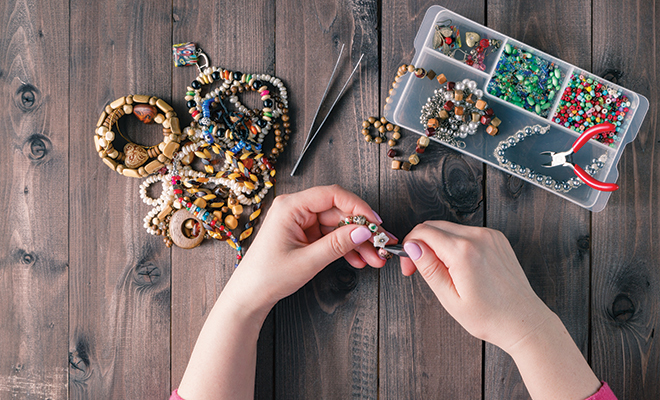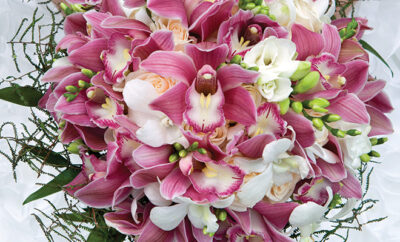
Expression with Hand-Crafted Jewelry
Are you looking for a gift that’s unique, creative and personalized for the recipient? Hand-crafted, heirloom-quality jewelry checks all the boxes and can be as much fun to give as it is to receive.
Take a look at fashion for the season, and tap your inner diva. All you need to get started are a few simple tools and supplies, along with willingness to learn a new skill.
Techniques
Two of the easiest jewelry-making techniques are threading and wire wrapping. With threading, beads that have a hole drilled through them are strung one after another onto a wire or string. With wire wrapping, a decorative setting is created from wire for a bead, which can then be strung with other beads or hung from a chain as a pendant. Wire-wrapped settings can be created for irregularly shaped stones as well as beads.
Materials
Most craft stores today carry a wide selection of glass and plastic beads, which are fine for creating casual jewelry. Better-quality jewelry requires gemstone beads. According to Barbara Case, author of Making Jewelry with Gemstone Beads, there are three types of natural gemstones: precious (diamonds, sapphires, rubies, and emeralds); semi-precious (such as amethyst, topaz) and ornamental (jasper, obsidian, agate). Across these types you can find stones in a wide range of colors, shapes and sizes. Gemstone beads are usually sold in specialty bead shops, at gem fairs and online.
For threading, it’s important to use strong wire that will stand up to the weight and uneven surfaces of gemstones. When working with gemstones, it pays to use wire from Beadalon, Accu Flex or Soft Flex. Each brand offers nylon-coated wire in a variety of diameters and flexibilities.
Unlike threading, where the wire is mostly hidden, wire becomes a design element with wire wrapping. For these projects, there are wires available made from copper, sterling silver and gold compounds; the choice should coordinate with the gemstones being wrapped. Wire is sold according to gauge, or thickness, in which a higher gauge number indicates a thinner diameter. While 24-gauge wire is fine for threading, thicker 14-gauge or 18-gauge wire is needed for wire wrapping.
Equipment
You don’t need to buy a lot of expensive tools to get started. You’ll need cutting pliers to cut the wire and flat-nosed pliers to hold it. Wire wrapping also requires a pair of round-nose pliers for bending wire and making loops.
In addition to pliers, you may also want to invest in a beading tray. These inexpensive containers allow you to design and lay out a necklace or bracelet before threading. A beading tray is especially useful when working with gemstone beads, since they are hand cut and usually not uniform in size. Laying them out ahead of time will save you the effort of shuffling beads around after they’re strung. Look for a beading tray that comes with a cover so you can put your work aside and return to it later.
Types of Gemstones
Agate is one of the most commonly used stones for jewelry and it’s available for about the same price as quality glass beads. There are many varieties available, including those that have been colored with dye. Jade is another popular gemstone for jewelry; it’s available in both inexpensive and costly varieties. Turquoise is an opaque gemstone that is moderately priced and available in many sizes and shapes. Another opaque stone, lapis lazuli, is prized for its rich blue color; it can be expensive but varies in price depending on quality.
Aquamarine and emerald are members of the same mineral family. While moderately-priced beads made from aquamarine can be found, emeralds are at the high end of the gemstone scale. Like rubies and sapphires, emeralds are most often used in stone form because they are so pricey. Garnet gemstones can be made into beads and are an inexpensive substitute for rubies.
Pearls aren’t technically gemstones because they aren’t formed by the earth, but they are considered to be a precious material for jewelry. Ranging in color from white to cream and iridescent gray, natural pearls are the most expensive variety and are available in both bead and stone form. Cultured and glass pearls are frequently used as substitutes. Both natural and cultured pearls that have been dyed are available in a rainbow of colors.
Getting Started
Before you begin to make jewelry, you’ll need a design. Pinterest and Etsy are great sources for inspiration when it comes to jewelry design. So are instructional books, sales catalogs such as Sundance and jewelry-making supply catalogs. You’ll need a couple of comprehensive how-to books about jewelry making such as the previously mentioned Making Jewelry with Gemstone Beads and Creative Bead Jewelry by Carol Taylor. You can also find how-to articles and videos on YouTube and other websites. The basic techniques you’ll need to learn are not difficult, but like many other endeavors, practice makes perfect! ■
Sources: craftsy.com and thespruce.com.







